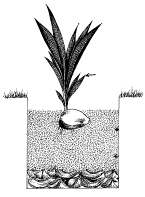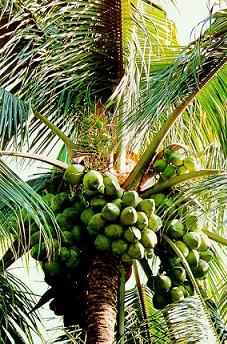|
Production of quality planting materials
Nursery
Selection and preparation of site for nursery
Nursery sites should be well drained with light textured soil and with adequate
but not too much shade. In open areas, provide shade during summer. Prepare beds
of 1.5 m width and of convenient length with 75 cm space between beds. In areas
where drainage is poor, prepare raised beds.
Before planting, examine seed nuts and discard those without nut water and rotten
kernels. Sow the nuts in the nursery after commencement of southwest monsoon during
May-June.
Spacing of nuts
Plant the seed nuts at a spacing of 30 cm (between rows) x 30 cm (between nuts)
with four or five rows per bed.
Method of planting seed nuts
|
Plant the seed nuts in the beds in trenches 25-30 cm deep and cover with soil so
that top portion of husk alone is visible. The nuts may be planted either horizontally
with the widest of the segments at the top or vertically with stalk-end up. Vertical
planting is preferable on account of convenience in transporting and lesser risk
of seedling injury.
Care and management of nursery
Provide protective fencing to the nursery if it is located in open area. If the
soil is sandy, provide mulching immediately after the cessation of monsoon rain.
Irrigate the nursery once in two days during summer months. Keep the nursery beds
free of weeds by periodic weeding. If termite is noticed, remove soil in the affected
area up to a depth of about 15 cm and dust soil and nuts with carbaryl or chlorpyrifos.
Repeat if attack persists. Periodically spray the plants with 1% Bordeaux mixture
or any other copper fungicide to prevent fungal infection.
|

|
|
Selection of seedlings
Remove seed nuts, which do not germinate within six months after sowing as well
as those with dead sprouts. Select only good quality seedlings (9-12 months old)
by a rigorous selection based on the following characteristics.
- Early germination, rapid growth and seedling vigour.
- Six to eight leaves
for 10-12 month old seedlings and at least four leaves for 9 month old seedlings.
-
Collar girth of 10-12 cm.
- Early splitting of leaves.
|

|
Note: The recovery of quality seedlings
will be about 60-65%. Since early germination is one of the criteria for the selection
of seedlings, the storing and sowing of seed nuts should be in lots rather than
in a staggered manner.
Removal of seedlings
Remove seedlings from the nursery by lifting with spade and cutting the roots. Keep
the seedlings in shade and do not expose to sun. Plant seedlings as early as possible
after removal from nursery. Never allow lifting the seedlings from the soil by pulling
the leaves or stem.
D x T HYBRID PRODUCTION
The following guidelines are suggested for large-scale production of D x T hybrid
seedlings. Assisted pollination should be done to get maximum hybrid nut production.
As far as possible use prepotent palms as parents in the hybridization programmes.
|
Selection of mother palms
Palms with the following phenotypic character combination may be selected for hybridization
work.
- Nuts without ridges and having yellow, orange or red colour.
- Palms with
overlapping female and male phases
- Small crown and canopy compared to that of
tall palm.
- Narrow stem without any bulging at the base with close leaf scars
|

|
Hybridization
- Use mixed pollen from identified tall palms.
- Emasculate the inflorescence
by cutting the male flowers with scissors and stripping if necessary within 5-7
days of opening the spathe.
- Cloth bags made of very close mesh should be used
for covering the inflorescence.
- Hairy caterpillar larvae cause serious damage
by boring into the female flowers and developing buttons through stigmatic ends.
The damage is more serious under bagged conditions. Spraying 0.15% carbaryl suspension
mixed with 1% fish oil soap or sandovit ensures protection from the larvae. Spraying
may be done prior to pre-pollination bagging.
- Dusting of pollen-talc mixture
in 1:9 proportion using pollen dispensers is recommended.
- Assisted pollination
for at least 3-5 days on each inflorescence till last female flower becomes receptive
and fully pollinated.
- Remove bags after the seventh day of pollination of the
last female flower.
Nursery
The nuts should be harvested before it is tree-ripe and sown immediately in the
bed without storage. Nursery beds should be mulched or shaded and watered regularly
and adequately.
|